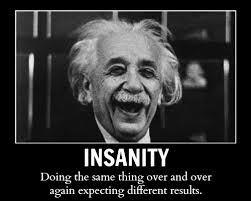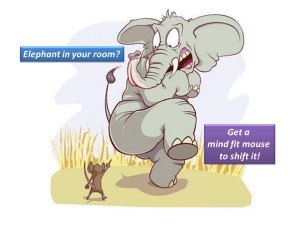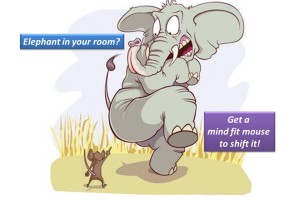The Elephant in the Room – Do you know how much it costs?
The ‘Elephant in the Room’ is a metaphorical idiom for an obvious truth that is going unaddressed. These ‘Elephants’ are commonly something we know about but choose to ignore and it often applies to an obvious problem or risk that no one wants to discuss – they are a taboo subject. However, the one thing these ‘Elephants’ have in common is that while they exist and remain untreated, they interfere and often will completely stop progress.
- How aware are you of the ‘Elephant in the Room’ in your organization?
- What does it cost to ignore it?
- Have you got one or more?
- And how much time, effort and money are spent feeding them?
Simply by acknowledging that the ‘Elephant in the room’ exists is a good first step. Now valuing it becomes easy as it is mostly about time that’s lost. So in terms of time lost an ‘Elephant’ can easily take one hour a day away from the productive time for each employee. Let’s put a nominal amount of £50 per hour as a cost of employee time. The average employee works 210 days a year. If they waste one hour per day that equates to 210 hours wasted giving a cost of £10,500 per year lost. For 10 employees that amounts to £105,000 and 100 employees a staggering £1,050,000.
Don’t we really need to take the ‘Elephant in the Room’ seriously and not bury our heads in the sand?
What would you do if you had an extra hour a day to apply focused effort on what is important to your business?
A Challenge for You
As you read this article keep an open mind as to what is really happening in your organisation and your own thought process.
- First, do not believe what you are about to read – but think about what is said and ask questions of yourself and your organisation
- Next, try and answer some of the questions that you are presented with – truthfully
- Now investigate what you have read and compare with your answers to prove or disprove your beliefs
- At any time did you change your beliefs or have you chosen to ignore what you have read or discovered?
- If the latter – what is your reason? What will you do now?
What is really going on in the brain?
One Universal Human Trait is based on what we believe is ‘the’ truth. We ignore or reject reality and defiantly refuse to check out the reality. We accept what we believe as a fact.
This however results in a lot of wasted time, effort and money.
- Our beliefs shape the facts as we want them to be
- Our beliefs form our attitude.
- Our attitude drives our behaviours.
- Negative behaviours are non-productive.
- The result – Behavioural Waste™ is generated.
What is Behavioural Waste™?
Behavioural Waste™ involves forms of behaviour that can be usefully removed or reduced, which prevent us from achieving our purpose and which reduce our effectiveness or the effectiveness of other people.
Beliefs lead to Behavioural Waste™
- Behavioural Waste™ can be Personal, Cultural and Systemic
- Behavioural Waste™ costs significant time, effort and money
- Behavioural Waste™ impacts negatively on performance and productivity
How much Behavioural Waste™ does your organisation create?
How much does it cost?
Examples of Behavioural Waste™
| Personal | Cultural | Systemic |
| Work on own agenda that conflicts with organisational purpose | Meeting agendas poorly drafted, late starting and lack control | Consistently produce data that is not needed or wanted |
| Looking for ways to sabotage people or the organisation | Leaders use aggressive telling tactics and make all the decisions | Focus on keeping cost down regardless of purpose or business imperatives |
| Talking too much often loudly to prevent others intervening | Emails sent out in a poorly structured way to everyone to protect sender | Driven by Lean Management without considering impact |
| Constantly use language of management speak (MBA’s/MA’s) | Tell stories which are believed to be true but are myths and damaging | Focus on systems that ‘do things right’ and not ‘do the right thing’ |
Which ones do you recognise?
What others have you identified?
Beliefs increase complexity
Organisations are complex enough in our high demanding and fast moving environments so why would we want to make it worse? Why do we make it worse by ignoring reality and putting solutions to perceived problems into the mix that fail to deliver the purpose of why we exists in our work context? People simply keep doing what they have always done with a belief that one-day it will deliver.
One of the effects of ignoring the ‘Elephant in the Room’ is that we put more energy into systems and processes that over time lose pace with the real world and become more and more rigid demanding more feeding.
Here are some examples of how to waste time by not checking out reality. None of the examples really work yet we keep doing them:
- Engaged – Disengaged workers. Disengagement is a major issue. For years specialists have tried to solve the problem and they measure it year in year out to see how bad it really is. Gallup in 2013 found disengagement to be 83% in the UK. Professionals keep delivering exciting development programmes to address the problem yet disengagement remains high. The confusion is that organisational interventions are based on keeping people, to keep them happy with gimmicks to engage them, whilst engagement is nothing but a state of mind.
- Lean management. Lean programmes has a failure rate of between 50% and 95% and the reasons are well known but there’s a commitment and a ‘let’s do it anyway’ approach. Lean makes sense and it is a logical approach and what’s more is generally needed, however if the workforce does not engage then it is ultimately doomed.
- Change management. Regularly quoted as having a 70% failure rate so you are not alone if you are one of those. Once again you will often find ‘people’s’ beliefs and attitudes behind the failures.
- Absenteeism. About 140 million working days or more are lost every year in the UK through sickness with many more in the public sector than the private sector. Despite many initiatives, sickness persists at an unacceptable high level. Yet we keep doing the same things to tackle the problem.
- Systems Thinking. It has been around since the 1960’s and although new words are used to describe what it is, nothing has really changed. It has a high level of failure rate sometimes caused by the focus on efficiencies that tend to dominate and ignores effectiveness relating to people. In addition, systems thinking tends to tell you more about the provider’s preferences than the problem itself. So you end up admiring the method but alienated by the poor results.
- Knowing – Doing. This is a big one. In fact it’s huge! For decades it has been assumed that knowledge leads to learning; learning changes attitudes and behaviours that in turn lead to improved results. Unfortunately, except in hard skills, this belief ignores the reality. Research shows a poor connection between learning and doing, so poor that the CIPD described it in 2007 as ‘no better than random chance’ and Donald Kirkpatrick of ‘evaluation of training fame’ said in 2005 that ‘There is a devastating disconnect between learning and behaviour’. It is actually very simple to link behaviors with performance and learning however, that is another story.
What initiatives has your organisation tried?
Did they work?
How do you know?
If something is not working why waste time, effort and money on repeating the measures or on applying interventions that mainly fail except in a small number of cases? It is as though we want to change just as long as it doesn’t involve having to think in depth where we might discover what is really going on. Our approach and solutions to the issues are handled in a cosmetic way. Is it time to do something else?
Why do we buy solutions, which may have little effect?
What is that something else?
What’s needed is a role that closes the gap between what we believe is working and reality. These people will identify the ‘Elephant in the Room’ that needs to be removed and no longer ignore it but start the process to remove it. We call them Mind Fit Investigators.
The Mind Fit Investigator
Description – A person who carries out an inquiry or investigation to establish the facts and truth about something. They are often experts in their field, although some can operate in different context. They may not be a specialist in a narrow area such as a remedial farrier, vehicle examiner, a biochemist or in Forensic IT. What they are is highly aware, able to access and translate information and data, and act accordingly. In the world of organisations their actions are focused on delivering benefit to that organisation.
The Investigator asks those tough questions
There is a very essential reason that tough questions must be asked to evidence reality and that relates to another Universal Human Trait, that of pattern recognition. Humans are designed to pick up cues in our world, originally for survival, to find food or avoid danger. Today, those cues are used in a whole variety of situations such as risk assessments in Health & Safety, gaps in player formation on a rugby field, a fire investigator searching for the cause of a fire, or airport baggage screeners looking for suspect articles.
However, there is a danger as we sometimes see patterns when they do not exist and this can lead to a lot of wasted time and cost when there is no need. False patterns are one of the areas that the Investigator seeks to discover. The wrong pattern linked to false beliefs can generate more wasted effort.
The ‘Investigator’ operates, often at a senior or departmental level on behalf of the directors of an organisation, by exploring those activities at the point of convergence between:
- The vision, purpose and key strategies at the top of an organisation
- The systems and processes that operate to deliver the purpose, directly or indirectly
- The attitude and behaviour of people
- Individuals personal reason for being in the organisation
- The culture and its impact across the organisation
- The link with the customer/client
The ‘Investigator’ asks tough questions of people, leaders and teams, which may start like this:
- Are you doing the right thing?
- How do you know?
- Does it work?
- Where is the evidence?
- How much of your time is actually spent on work that ultimately delivers, directly or indirectly, the organisational purpose and meets the needs of your clients?
- How much time do you waste locked into non-productive activities such as routine meetings or running demanding systems and processes?
- If we could improve your role what would you do and what part would need to be done by others to give you the time to improve?
From this initiating point ‘Investigators’ enquire and probe to discover those small input variables that lead to the current performance and productivity or cause time consuming and expensive Behavioural Waste™. They seek opportunities for the organisation to improve and grow simply by exploring ways that result in performance improvement rather than management of performance. Their focus is the Purpose of the organisation to ensure that it is being delivered and moving towards its Vision.
Put simply the ‘Investigator’s’ role is crucial. Without them the ‘Elephant in the Room’ will keep growing and need constant feeding. Here is a summary of the ‘Investigator’s’ role:
- Identify the ‘Elephant(s) in the Room’ – evidence it
- Identify, evidence and remove Behavioural Waste™ – personal, cultural and systemic
- Explore Convergent Points for effectiveness and efficiencies to ensure that they deliver what is needed – evidence it
- Identify Growth opportunities to increase performance improvement – evidence it
However, if you choose to ignore or resist reality the results will be as they have always been. Is that good enough?
The choice as always is yours.
What’s your choice?
Do you want to know how you can develop Mind Fit Investigators? Click Here




